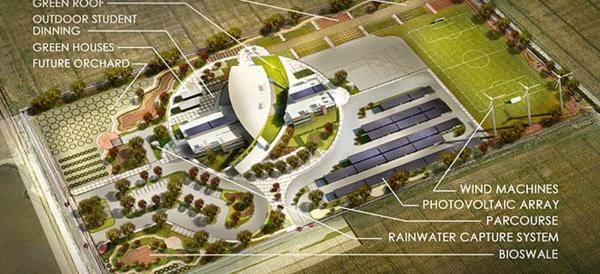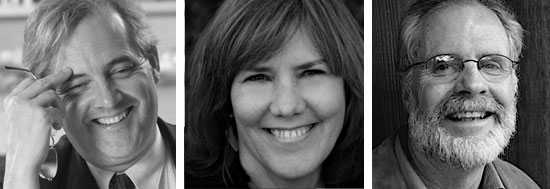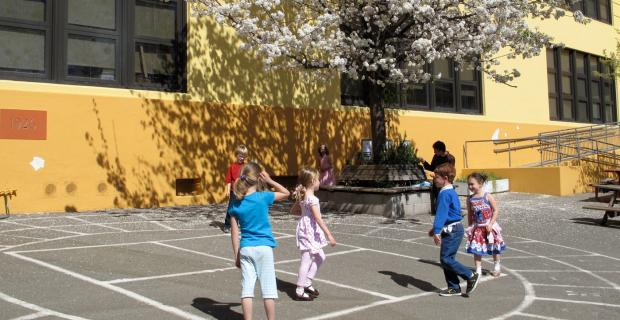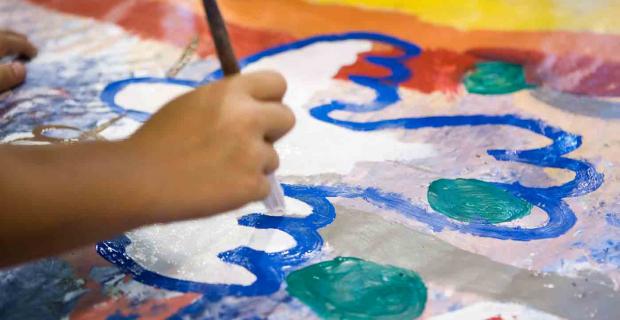When the Building Is the Teacher

In 2010, former Center education program director Carolie Sly was engaged with Rainforth Grau Architects, GreenWorks Studio, and the Lodi Unified School District in California's Central Valley on design of a new STEM [Science, Technology, Engineering, and Mathematics] Academy for the district.

In February 2012, the project received an Award of Excellence from the Coalition for Adequate School Housing and the American Institute of Architects, which commended the sustainable design and clear link between physical design and curriculum.
The planned campus's many sustainable features will include maximizing natural daylighting and indoor environmental quality, incorporating bioswales for management of surface water, and a goal of achieving grid-neutral status through energy conservation and production of electricity through photovoltaics and wind power.

Much more than "green," though, the Lodi campus is intended to enhance learning, to be a teacher itself, and to support a unique curriculum organized around major themes of green technology: "Design," "Build," and "Grow." Throughout this curriculum, students will imagine, invent, experiment, and collaborate on real-world projects that reflect the principles, knowledge, and skills that will be needed for sustainable living.
In the discussion below, Center senior editor Michael K. Stone, architect John Dale of GreenWorks Studio (a focus group of Harley Ellis Devereaux), and Carolie Sly explore how campus, teaching, and learning complement each other.
Michael Stone: When you think of the role that campus design plays in students' learning experiences, what comes to mind?
John Dale: I'm old enough to have gone through different eras of school design. We went through the factory model, where we had long, linear schools, single rows of classrooms. Then we got into this era when oil was cheap, and everyone thought air conditioning was a big innovation. So we built what I now call "multi-useless spaces" — big, black windowless boxes with no walls inside, that were thought to be the ultimate in flexibility. Eventually they carved them up with corridors, punched windows through the walls, and made them conventional again, because they didn't work.
I think that progressive curriculum now is increasingly reflecting the fact that kids learn in different ways. Sitting in one classroom with a single teacher imparting knowledge is not necessarily the only way or the ideal way to help children develop their abilities to learn and absorb and do original research, to prepare them for an unpredictable world.

Sometimes kids are much better off working on a very specific project from which they draw their own conclusions. A curriculum that supports different learning intelligences requires a different collection of spaces. So you start thinking about suites of rooms, where one space opens onto another. They're of different sizes, with different degrees of intimacy, and different physical qualities.
Carolie Sly: I started teaching during that time of no walls between classrooms. We thought that by being able to see and hear each other we'd be more community oriented, but it just drove me nuts as a teacher, because it was so noisy. We ended up having to build walls. It was in some ways fortunate that we went through that period, because now that we're going back to wanting kids to have room to collaborate and work together on big projects, we have learned that we still need individual spaces for quiet work. It's so much more respectful of the learner.
We can't necessarily predict what they'll be learning ten years down the road, but if we can build it right, then it should be able to change and accommodate.
MS: Are there elements that you think will persist through future changes?
CS: I think we'll always need a space where people can sit and hear a lecture, though that won't be the dominant format like we've have had in most high schools. On the more innovative side, the Lodi school has the Grow Studio and the Build Studio and the Design Studio — bigger spaces where students can make and experiment with bigger, three-dimensional things. Those studios will probably be there as long as the school lasts.
JD: If you go back, the first progressive schools and the earliest public schools were built around the idea of light and air. There was an understanding that schools should be healthy places to be, and I think that's a constant. Now we're actually relearning lessons that were well known. I have a lot of old architecture magazines. It's interesting to go back to the 1950s and see case studies on the front covers about healthy classrooms that had balanced natural light and air.

From a sustainability point of view, we need to do everything we can to reduce energy consumption, to design buildings that can inherently breathe, that will work when mechanical systems are off, where you don't have to have electric light on all the time. We need buildings with different modes of operation, so there's a certain freedom for an individual to adjust the environment. I think that is another important principle.
MS: Are you also finding that some of the same elements that are energy efficient also make a building better for learning?
JD: I think about the first school we had our daughter in. Although the classroom had windows in two directions, the blinds were closed all day. I thought, "That just seems wrong." I think it's been established that you might actually be able to take in information better if you can look out a window and see something in the distance — that what you absorb doesn't require you to be staring with a fixed viewpoint at one person in one place. Being able to wander around and shift in your chair and keep adapting and adjusting to your personal comfort actually allows you to remain focused.
MS: At one point it was assumed that if kids could look out the windows, they'd be distracted. Now we seem to be finding out exactly the opposite, that they can focus better with those "distractions."
CS: Exactly. We went through a period not very long ago where schools would paint the windows so that kids could not see outside. The windows were really considered an interference to the learning process.
MS: How do you design buildings that are teachers?
JD: Lodi has a hot climate, so we need mechanical cooling, but the system is very energy efficient, and it's very visible. The mechanical engineer invented something that required both a cooling tower and a solar tower working in conjunction. Every day, they're going to be visible. The mechanical is not something hidden away in the basement or something where no one knows what it is and how it works. There's a par course that runs all around the perimeter of the site, and we've considered a bicycle station that will make electricity. You're moving and you're creating energy, and you're seeing the results of it.
We're going to grow crops on the campus. There's a commitment to having people get their hands dirty and actually do it and understand it. We thought in the early stage that it would be great if we tried to get rival photovoltaic manufacturers to do different installations so that the kids could study the different performance levels.
CS: And they're planning to have a "dashboard" so kids can monitor energy and resource use and track changes in the building over time.
A lot of times, schools will be built in a way that's green, but it's not transparent to the kids. If we build in transparent elements then it's also part of the learning. To me, that means that we're jump-starting the learning curve of society's understanding of why we have to have these things.
If we install them in schools but the students don't learn why, it's not going to have the impact of preparing them to be citizens who understand why we live the way we do.
JD: The best way to understand it is to have to do something and experience the effect. We haven't built it yet, but we designed a small black box theater for a Waldorf School in Northridge. We said, "It's the first space of its kind in the school that will be used for everything. We can have blackout shades, but we want natural light," so we included clerestory windows. Then we thought that if we had another door onto the hillside behind the stage, we could do outdoor performances, but also pull in air. The inside is made out of masonry, and it's got mass. We could open the clerestory windows and the doors at night and have a kind of perforated screen that provides security and let the air flow in because in Northridge it's 120 degrees during the day, and it's 60 degrees at night.
Then we said, "We could put it on a controller. We could have a push button," and we said, "No, let's make it manual." It will only work if the students and the teachers actually do the manipulation. Then they'll discover that they can cool down the building and save a lot of energy. They'll have been responsible for making it happen. Which of those methods are you going to remember? What's going to become part of your consciousness? Obviously what you've experienced.
MS: What happens where you're not building a new school, but having to work with buildings that are already there?
JD: Sometimes old buildings have the right bones. They just have to be uncovered again. We've been working on a high school in Southern California where all the older classrooms were built in the fifties. They all face north and south. The north windows are huge, facing onto a little garden court that's green and with trees. And the south face — they're high windows. So you get cross-ventilation. The original brief was to tear those classrooms down and put up some new two-story buildings in the center of the campus. We came back and said, "Maybe you should just renovate those buildings. Let's just make them work the way they were intended to." Sometimes the buildings are right. If they're not right, you can bring light in from above. You can create more appropriate cooling systems and so on that are more energy efficient. You can add photovoltaics. There are lots of things you can do.
MS: How do the different people responsible for facilities and curriculum work together in a project like the one in Lodi?
CS: The Lodi STEM Academy has been the brainchild of the Assistant Superintendent of Facilities, Art Hand. While many people contributed to the vision, Art has kept the process going. He is determined to make it a reality, yet also really listens to the naysayers.
I came into the process after the initial design phase. My input was about how this would work for the teachers and the kids. As they move around physically and use this as their learning environment, how will its structure need to change to optimize learning?
And then they brought in a few teachers, and I think we really started making headway in terms of the marriage between the curriculum and the building. I wrote the philosophy and curriculum parts of the site plan. but ultimately the teachers will work with me to modify it so it speaks for them.
JD: The teachers were very effective at saying, "You've got this space opening into this space, but what if I have three groups and I have to be able to see all of them at once?" It got very concrete, and that was very valuable. We were learning that the space can't be quite what we thought, because they won't use it if we do that.
I think any district with enlightened leadership will clearly understand the value of doing that. We've done workshops that not only involved teachers and parents and administrators, but sometimes even involved the kids. That's really fun.
We did a project at my daughter's school in Pasadena. We had a Saturday workshop to look at the two sites that are part of our school, and we had eighty people come — middle schoolers, primary school and lower school kids, parents, teachers, administrators. We divided everybody into groups and invited each group to work on the same problem for a couple of hours.
So who were the most productive people in the workshop that day? Who produced the most in the amount of time allotted? It was the elementary school kids, because they were first given the problem of designing their own ideal learning space, and they all built models of the things that they really cared about. Then they tackled the big problems. Then they went out and played, because they were done. The adults were still trying to figure out where to put the first pieces.
The children led the way. They were confident. Some of the ideas weren't the most sophisticated, but they were worth thinking about and incorporating in some way. We literally went back and took all their models and looked for the startling things, for the common ground between them, and found things that will lead to the next stage of what we do.
CS: Most teachers never in their lifetimes get to be a part of designing their physical space. So I can just see their imaginations catching on fire, because they finally get to really be a part rather than inheriting the space.

Left to right above: John Dale, Carolie Sly, Michael Stone



